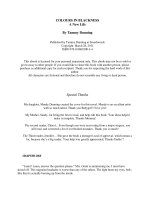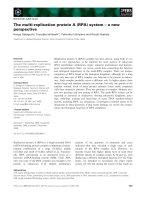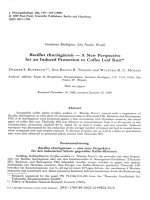ENTREPRENEURSHIP entrepreneurship a new perspective
Bạn đang xem bản rút gọn của tài liệu. Xem và tải ngay bản đầy đủ của tài liệu tại đây (2.66 MB, 198 trang )
Entrepreneurship
The entrepreneur has been neglected over the years in formal economic theorizing.
Previously there has been only eclectic theories, such as human capital theory and
network dynamics which discuss certain aspects of entrepreneurial behaviour. This book
closes a gap in the entrepreneurship literature.
Inspired by modern physics, the author brings together an evolutionary methodology,
along the way implicating quantum, graph and percolation theory. This book provides an
interdisciplinary approach to entrepreneurship, opening up new ideas in modelling:
• how to structure economic thinking in an easy way
• how to implement new ideas into a simulation study
• how to balance line modelling procedures with stylised facts.
Thomas Grebel has provided a synthesis of all the main theories of entrepreneurship and
the original thinking within this book should be of interest to all those working in the area
of business and management as well as economics.
Thomas Grebel is lecturer in Economics at the University of Augsburg, Germany.
Studies in Global Competition
A series of books edited by John Cantwell, The University of Reading, UK
and David Mowery, University of California, Berkeley, USA
Volume 1
Japanese Firms in Europe
Edited by Frédérique Sachwald
Volume 2
Technological Innovation, Multinational Corporations and New International
Competitiveness
The Case of Intermediate Countries
Edited by José Molero
Volume 3
Global Competition and the Labour Market
By Nigel Driffield
Volume 4
The Source of Capital Goods Innovation
The Role of User Firms in Japan and Korea
By Kong-Rae Lee
Volume 5
Climates of Global Competition
By Maria Bengtsson
Volume 6
Multinational Enterprises and Technological Spillovers
By Tommaso Perez
Volume 7
Governance of International Strategic Alliances
Technology and Transaction Costs
By Joanne E.Oxley
Volume 8
Strategy in Emerging Markets
Telecommunications Establishments in Europe
By Anders Pehrsson
Volume 9
Going Multinational
The Korean Experience of Direct Investment
Edited by Frédérique Sachwald
Volume 10
Multinational Firms and Impacts on Employment, Trade and Technology
New Perspectives for a New Century
Edited by Robert E.Lipsey and Jean-Louis Mucchielli
Volume 11
Multinational Firms The Global-Local Dilemma
Edited by John H.Dunning and Jean-Louis Mucchielli
Volume 12
MIT and the Rise of Entrepreneurial Science
Henry Etzkowitz
Volume 13
Technological Resources and the Logic of Corporate Diversification
Brian Silverman
Volume 14
The Economics of Innovation, New Technologies and Structural Change
Cristiano Antonelli
Volume 15
European Union Direct Investment in China Characteristics, Challenges and Perspectives
Daniel Van Den Bulcke, Haiyan Zhang and Maria do Céu Esteves
Volume 16
Biotechnology in Comparative Perspective
Edited by Gerhard Fuchs
Volume 17
Technological Change and Economic Performance
Albert L.Link and Donald S.Siegel
Volume 18
Multinational Corporations and European Regional Systems of Innovation
John Cantwell and Simona Iammarino
Volume 19
Knowledge and Innovation in Regional Industry
An Entrepreneurial Coalition
Roel Rutten
Volume 20
Local Industrial Clusters
Existence, Emergence and Evolution
Thomas Brenner
Volume 21
The Emerging Industrial Structure of the Wider Europe
Edited by Francis McGowen, Slavo Radosevic and Nick Von Tunzelmann
Volume 22
Entrepreneurship
A New Perspective
Thomas Grebel
Entrepreneurship
A New Perspective
Thomas Grebel
London and New York
First published 2004 by Routledge 11 New Fetter Lane, London EC4P 4EE
Simultaneously published in the USA and Canada by Routledge 29 West 35th Street, New York,
NY 10001
Routledge is an imprint of the Taylor & Francis Group
This edition published in the Taylor & Francis e-Library, 2005.
“To purchase your own copy of this or any of Taylor & Francis or Routledge’s collection of
thousands of eBooks please go to />© 2004 Thomas Grebel
All rights reserved. No part of this book may be reprinted or reproduced or utilised in any form or
by any electronic, mechanical, or other means, now known or hereafter invented, including
photocopying and recording, or in any information storage or retrieval system, without permission
in writing from the publishers.
British Library Cataloguing in Publication Data A catalogue record for this book is available from
the British Library
Library of Congress Cataloging in Publication Data A catalog record of this book has been
requested
ISBN 0-203-47874-6 Master e-book ISBN
ISBN 0-203-67242-9 (Adobe e-Reader Format)
ISBN 0-415-34118-3 (Print Edition)
Contents
Figures
Plan of Book
Acknowledgments
List of Symbols
I The Critical Path of the Entrepreneur in Economic Theory
1 A Historical Sketch of the Research on Entrepreneurship
X
Xiii
Xvi
Xvii
1
3
2 The Neoclassical Era
12
3 The Austrian School
22
4 Synthesis and Summary
35
II From the Evolution of Economics to the Economics of Evolution
38
5 Evolutionary Economics
39
6 Synthesis of Evolutionary Ideas
49
III Modelling Entrepreneurship from an Evolutionary Perspective
62
7 Point of Departure
63
8 The Homo agens in a Socio-Economic Context
68
9 The Model
96
10 Conclusions and Prospects
125
APPENDIX
128
A Quantum Theory
130
B Percolation
136
C Social Networks
138
D Basic Entrepreneurship Model
142
Bibliography
150
Index
159
Figures
1.1 Economists contributing to entrepreneurship research
5
1.2 The production system of Jean-Baptiste Say
7
1.3 The income distribution of Jean-Baptiste Say’s system
8
2.1 The graphical representation of the consumer’s and producer’s
optimization problem
14
2.2 The neoclassical production function
15
2.3 The general equilibrium system
16
2.4 The comparative statics system
19
3.1 The circular flow
30
3.2 The innovation process in Schumpeter’s theory
32
5.1 An overview of the philosophy of science
41
6.1 Heisenberg’s uncertainty principle adapted to economics
52
6.2 An economic system
56
6.3 The null system
57
6.4 The complete system
57
6.5 The hyperstructured firm
58
7.1 The basic building blocks
66
8.1
The diffusion of information/knowledge with bounded rational
actors
71
8.2
The square lattice
72
8.3
The dependence of some of the percolation quantities on p, the
fraction of occupied sites, in site percolation on a simple cubic
lattice
74
8.4
Percolation within a square lattice
75
8.5
Actors within a lattice
75
8.6
Percolation—agents with heterogeneous absorptive capacities
77
8.7
The dynamics of knowledge diffusion
79
8.8
The mental model-the agent as a “creative observer”
82
8.9
The agent within a social network
87
8.10 Social network dynamics with ε=0
90
8.11 Social network dynamics with ε=1
91
8.12 Social network dynamics with ε=2
91
9.1
Basic structure of the model
103
9.2
The diffusion of knowledge with a low, medium and fast rate of 105
diffusion
9.3
The sector’s turnover with a low, medium and fast rate of
knowledge diffusion
106
9.4
The number of firms within the sector with a low, medium and
fast rate of knowledge diffusion
107
9.5
Entry and exit with a low, medium and fast rate of knowledge
diffusion
108
9.6
Net entry of firms with a low, medium and high rate of
knowledge diffusion
109
9.7
The founding threshold with a low, medium and high rate of
knowledge diffusion
110
9.8
The industry life cycle—assuming a high rate of knowledge
diffusion
113
9.9
The industry life cycle—assuming a medium rate of knowledge 114
diffusion
9.10 The industry life cycle—assuming a slow rate of knowledge
diffusion
115
9.11 Swarms of firm foundations
116
9.12 Insolvencies of internet/E-commerce firms per month
118
9.13 Overall exits of internet/E-commerce firms
119
9.14 Entries and exits in the automobile industry
120
9.15 Entries and exits in the television industry
121
9.16 Entries and exits in the penicillin industry
122
A.1 Wave theory depicted in a Mach-Zehnder Interferometer
without obstacle
131
A.2 Wave theory depicted in a Mach-Zehnder Interferometer with
obstacle
132
A.3 Quantum theory depicted in a Mach-Zehnder Interferometer
without obstacle
132
A.4 Quantum theory depicted in a Mach-Zehnder Interferometer
with obstacle
133
Plan of Book
The entrepreneur has always been a pivotal point in economic history. His importance
has never been in doubt—neither in politics nor in economics. Indeed, there is evidence
that a high level of entrepreneurship creates jobs, economic growth and, hence, welfare.
It is the entrepreneur, a man of action, a heroic person, who is the key element of
economic prosperity. Turning to economic theory, however, specifically to orthodox
economic theory, the entrepreneur has gradually been deprived from that central position
in the economy. Due to the need for a consistent, normative theory in economics, in order
to explain the optimal allocation of scarce resources rather than to consider the
specificities of human behavior that may prevent (support) them from (in) doing so, the
entrepreneur was eventually knocked off his pedestal and made way for a
methodologically robust figure: the Homo economicus, a dispassionate seeker of
efficiency, a playmate of the methodological treatment.
In this work, the story of the entrepreneur in economic theory is briefly retraced.
Furthermore, a methodological discussion will provide a sound underpinning for a model
of entrepreneurial behavior. Thereby, it also tries to bridge the missing link in economics
and bring psychological and sociological aspects into economic theorizing. Therefore,
this book is divided into three major parts. Part I delivers an overview of the literature on
entrepreneurship. Part II takes up the methodological discussion about a basic
evolutionary setting. Part III rounds off the work with an evolutionary model on
entrepreneurship.
The historical sketch (part I) starts with eclectic ideas and the basic intuition on the
role of the entrepreneur. A collection of possible functions and qualities of the
entrepreneur is given at the beginning. Very early, the French School delivers lots of
insights into entrepreneurial functions. The Classical School rather puts its focus on
capital than on the entrepreneur. With the neoclassical era entrepreneurs have become
gradually eradicated, when the Newtonian mechanics were introduced in economic
theorizing; methodology smothered the tiniest contingencies of entrepreneurial actions in
theory. Due to the Austrian School, the entrepreneur was revived to stress his important
position within the economic process. Despite the contributions it made to neoclassical
methodology, the Austrian tradition initiated also a critical discussion of such
methodology. Schumpeter criticized the incapability of equilibrium analysis to
substantiate the innovation process as a fundamental element of economic change. The
endogenous element, Schumpeter put forth, is the entrepreneur, who pushes through new
combinations, i.e. innovations, and destructs any kind of presumed state of optimality,
which, quite contrarily, might never come into existence. Kirzner sought the entrepreneur
in disequilibrium but in contrast to Schumpeter, he did not refrain from a final state of
equilibrium. Knight discussed the idea of a parameterizable uncertainty, and came to the
conclusion that there is the differentiation of true uncertainty which does not allow for
any prediction, a state of economic ignorance which only an entrepreneur dares to cope
with. But none of those economists build a framework to suitably incorporate the
entrepreneur as a coherent feature into economic analysis. There was just the notion of an
alternative approach. It was the term evolutionary, which was meant to summarize all
heterodoxy in economic analysis contrasting some neoclassical shortcomings. Not
surprisingly, evolutionary economics rather became the allegory of economists’ yearning
for a standardizing body to tackle economic phenomena which had been reduced to
negligible side effects in the neoclassical economic process.
Consequently, the history of evolutionary economics is outlined in the second part
leading into a discussion about the philosophy of science. The parallels between natural
sciences, philosophy and social sciences point out the thread of rationality through all
sciences suggesting a deterministic view of the world. Taking into account the facts of
observable data, empiricism likewise followed determinism. Even the reconciliation
between both, rationalism and empiricism, did not give up a deterministic world view. In
the 20th century, the findings in physics, such as in thermodynamics and especially in
quantum physics, suggested accepting some indeterminism in nature; an idea that puts
into perspective normative theories as well as predictability; an unpleasant constraint for
scientific research in general and a fundamental critique on neoclassical economics in
particular. Hitherto, however, indeterminism also turned out to puzzle evolutionary
economists. The discussion in part II ends with a systematic methodological framework
adapting Heisenberg’s uncertainty principle to economic behavior in general and
entrepreneurial behavior specifically.
In part III, the core element of this book, the model of entrepreneurial behavior, is
gradually introduced. The pivotal point is the bounded rationality of actors, whereby the
bimodal ontology of the human mind, being a part of reality as well as an actively
creative element of reality, serves as a theoretical basis. Therefore, the psychology of
actors is laid out. A static perspective of the human cognition process, with regard to
human understanding and processing of new information and knowledge subject to
limited absorptive capacities, is developed. New technological knowledge has to be
absorbed by actors in the first place. Not before actors understand the principles of a new
technology, such as the functioning of the internet, they become potential innovators in
commercializing a new technology. Since the diffusion of knowledge is an
indeterministic process, it cannot be modeled analytically. Therefore, percolation theory
will serve as a metaphor and, apart from that, it will be used as a tool to implement this
idea into the complete model at the end of this book. Furthermore, the sociological aspect
of actors’ psychology is introduced, since the mere understanding of a technology does
not automatically make an entrepreneur out of actors. Decisions are made within a certain
context. Individuals might hesitate to run a business all by themselves, but might do so
when being supported by friends. In contrast to the behavior of the Homo economicus
there is symmetry-breaking in human behavior. This is one of the outcomes of part II
which is taken up on. Apart from what an actor’s friends believe, the overall evaluation
of a new technology by actors in general is crucial for entrepreneurial behavior. If the
economic potential of a technology is positively evaluated by actors, some are likely to
engage in entrepreneurial actions anticipating future economic developments. It is the
shared mental model of actors, influenced by socio-economic indicators on new
technologies and their economic applications that make actors confident of future
prosperity. Once actors are informed about a new technology and form a positive attitude
towards its economic applicability, they are activated in terms of entrepreneurial actions.
If the general attitude of actors is in favor of a new technology, actors who understand a
new technology and therefore are able to innovate on that technology (such as opening up
a bookstore on the internet), they start to engage in a networking process (chapter 8). In
case all contingencies coincide, some actors happen to come together at a certain point in
time and decide to found a firm. Conclusively, the basic findings in the entrepreneurship
literature (part I) and the meta-theoretical reflections delivering a methodological
foundation (part II), are brought together in part III. Thus, the characteristics of bounded
rational actors with an economic behavior subject to individual, sociological and some
indeterministic facts become the driving forces of entrepreneurial behavior. The results of
the model meet stylized facts, so that eventually a consistent evolutionary model of
entrepreneurial behavior based on a sound methodological framework is developed.
Acknowledgments
This book would have never been possible without the support of many people.
First of all, I want to thank my family: my parents and grandparents who raised me in
free thinking and making autonomous decisions; my brothers with their wives, and my
sister just for being there. Furthermore, I am very grateful to my friends who managed to
boost my motivation at harder times: Gerhard Ilg who discussed many drafts with me,
Karoline Strobl who never shied away from discussing details important to me, Rüdiger
Przybilla, my companion in writing his thesis, too. Hansjörg and Alexander Durz all
along with Lukas S.Schimpfle who spurred my entrepreneurial spirit from a practical
point of view. Thomas Konopka, Bastian Walcher and many more wonderful musicians I
share the passion for music in my spare time.
Many thanks also to my colleagues who have always been helpful and understanding:
Markus Balzat, who spent a lot of time discussing improvements of my work and
Andreas Pyka who got me started in simulation studies. Thanks to Monika Bredow, our
secretary, and to many other colleagues from our economics department. In particular, I
am very much indebted to Professor Dr. Horst Hanusch who gave me plenty of scope to
do research and thus made this book possible in the first place. Arnold Wentzel from the
Rand Afrikaans University in South Africa I thank for his proof-reading and his valuable
comments.
Last but not least, I want to thank Uwe Cantner. He has been giving me a lot of
guidance ever since we met. He always knew how to open up my mind and provoke a
creative way of thinking. Uwe and Fabienne, his daughter, have become close friends to
me.
List of Symbols
δ
ε
η
delimiter of a firm’s burning rate
degree of agents’ bounded rationality
price elasticity of demand
real wage rate
Г
кi
lag operator
absorptive capacity of agent i
minimal fraction of an agent’s direct
network members with a common
specificity
profit of firm j at time t
founding threshold
persistence of a shock on output
number
πjt
Ψ
ρ
τ
φ(t)
transferrable (non-tacit) knowledge
sustainable growth rate
vector
ai
ADt
ASt
b
cj0
ceqt
agent i
aggregate demand at time t
aggregate supply at time t
rate of knowledge diffusion
numeraire of unit variable costs
comprehensive endowments of group
q at time t
diffusivity
set of edges (connections)
edge between vertex i and j
entrepreneurial spirit of agent i
number of exits at time t
set of new firms at time t
De
E
eij
esi
ext
fjt
G
g
ge
H(x)
hjt
hci
inct
actual firm
effective elastic moduli
time parameter
effective electrical conductivity
heavyside function
oligopolistic interdependence of firm
j at time t
human capital of agent i
number of incumbent firms at time t
K
k
production factor capital
number of connections (ties between
agents)
firm’s total cost curve at time t
fixed costs
variable unit costs
L
lt
LDt
lr
LSt
M
m
N
n
Ni
nt
P
p
P(p)
pcb
pcs
Pjt
PFt
PFt
pfqt
pfqt
q
rut
S
s
S(A)
Sp(p)
t
ut
V
vci
production factor labor
units of production factor labor
employed in equilibrium at time t
labor demand at time t
learning rate
labor supply at time t
size of s system
number of temporarily potential firms
agents in the neighborhood
number of elements
neighborhood of agent i
number of firms at time t
nominal price
probability of a site being occupied
percolation probability
percolation threshold in the case of
bond percolation
percolation threshold in the case of
site percolation
product price of firm j at time t
planned priced of firm j at time t
production function at time t
set of potential firms at time t=0
potential firm at time t=0
potential firm’s evaluated
comprehensive endowment
agents of a k-group that constitute a
potential firm
positive return on sales
a system
number of distinct n-systems
adjacency matrix of a system
average number of clusters of size s
time index
growth rate of sector sales at time t
set of vertices (agents)
venture capital of agent i
W
Wi
XA(p)
XB
xexit,t
xjt
nominal wages
angent i’s stock of novel knowledge
accessible fraction
backbone fraction
total turnover of exiting firms at time t
output of firm j at time t
accumulated output of firm j at time t
planned output of firm j at time t
xsurv,t
xip(p)
Y
yjt
GPT
total turnover of surviving firms at
time t
correlation length
total output
price limit of firm j at time t
general purpose technology
Part I
The Critical Path of the
Entrepreneur in Economic
Theory
1
A Historical Sketch of the Research on
Entrepreneurship
The analysis of entrepreneurship has been one of the most challenging subjects in the
history of economic analysis. Research on entrepreneurship is as old as economic
analysis itself. The importance of entrepreneurs in economy has always been emphasized
but it has never come as far as to be develop into a consistent and comprehensive theory
on entrepreneurship. Why is that? When doing research on entrepreneurship, almost
every economist comes to a point where he wonders whether the entrepreneur does not fit
into orthodox economic analysis or, vice versa, orthodox economic analysis is not able to
explain the phenomenon of the entrepreneur. The literature on economic behavior seems
to comprise of a nearly holistic approach to the understanding of humankind’s way of
dealing with scarce resources. The literature on entrepreneurship, however, is eclectic and
almost fails to track the quintessence of entrepreneurial behavior.
When we talk about entrepreneurship, we talk about assumptional frameworks, how to
treat uncertainty, knowledge, rationality, etc.; and on top of it, we talk about
methodology. This is what makes it very difficult to tell a distinct story about the
entrepreneur leaving aside such kind of seemingly secondary aspects.
This part gives an overview on the work that has already been done on the topic of
entrepreneurship in the economic literature and, furthermore, the attempt is made to
categorize literature in order to track the development of the different strands of thought
leading to different paradigms in economic analysis and thus determine the apparently
symptomatic treatment of the entrepreneur.
1.1 The Pre-Neoclassics
It is not obvious at all where the actual starting point to analyze entrepreneurship is
found. When we look at the literature there are various suggestions how to approach
entrepreneurship.1 Casson (1990) provides a fourfold division of entrepreneurship
approaches: some focus on the factor distribution of income, some investigate the
entrepreneur’s role within the market process, others focus on a heroic Schumpeter vision
and the fourth group analyzes the entrepreneur in the context of a firm. Nevertheless, the
entrepreneur’s origin, his economic identity and his distinct economic role is still
puzzling. Hébert and Link (1982) assorted various “themes” which differentiations,
concerning the entrepreneur’s role, have been put forward in economic literature:
1. The entrepreneur is the person who assumes the risk associated with uncertainty (e.g.,
Cantillon, Thünen, Mangoldt, Mill, Hawley, Knight, Mises, Cole, Shackle).
Entrepreneurship
4
2. The entrepreneur is the person who supplies financial capital (e.g., Smith, Turgot,
Böhm-Bawerk, Edgeworth, Pigou, Mises).
3. The entrepreneur is an innovator (e.g., Baudeau, Bentham, Thünen, Schmoller,
Sombart, Weber, Schumpeter).
4. The entrepreneur is a decision maker (e.g., Cantillon, Menger, Marshall, Wieser,
Amasa Walker, Francis Walker, Keynes, Mises, Shackle, Cole, Schultz).
5. The entrepreneur is an industrial leader (e.g., Say, Saint-Simon, Amasa Walker,
Francis Walker, Marshall, Wieser, Sombart, Weber, Schumpeter).
6. The entrepreneur is a manager or superintendent (e.g., Say, Mill, Marshall, Menger).
7. The entrepreneur is an organizer and coordinator of economic resources (e.g., Say,
Walras, Wieser, Schmoller, Sombart, Weber, Clark, Davenport, Schumpeter, Coase).
8. The entrepreneur is the owner of an enterprise (e.g., Quesnay, Wieser, Pigou,
Hawley).
9. The entrepreneur is an employer of factors of production (e.g., Amasa Walker, Francis
Walker, Wieser, Keynes).
10. The entrepreneur is a contractor (e.g., Bentham).
11. The entrepreneur is an arbitrageur (e.g., Cantillon, Walras, Kirzner).
12. The entrepreneur is an allocator of resources among alternative uses (e.g., Cantillon,
Kirzner, Schultz).2
Besides the literature explicitly focusing on entrepreneurship, the related literature is so
huge that almost every subject in economic analysis is touched. So the entrepreneurial
element becomes a prevailing element within the economic realm. Nevertheless, it has to
be stated that the discussion, as done in orthodox theory, can also be lead without
referring to the entrepreneur at all; and paradoxically, the entrepreneurial element
decreases to a minor economic phenomenon not considered necessary to be taken into
account.
Owing to the elusiveness of the entrepreneur within orthodox economic theory, a brief
historical sketch will help to trace back the origin and the paradigmatic development of
the research on entrepreneurship in order to get into the discussion. Hébert and Link
(1982), Casson (1982) and Barreto (1989) among others have already given a profound
overview on the literature to be investigated.
Figure 1.1 depicts a possible categorization of economists that elaborated or touched
on the entrepreneur in his work.
1.2 The French School
Richard Cantillon (1680s–1734) Cantillon3 has to be seen as the precursor of the
research in entrepreneurship. Cantillon was renowned as a successful entrepreneur
himself (to use this term in a colloquial sense). He described economic life at his time:
landowners would lease their land to farmers and live on the rent they earn. A second
group, the hirelings, are employees who earn a fixed amount of money. The third group
of people Cantillon calls the undertakers; they take the entrepreneurial part in economic
life. The specific feature Cantillon associated with the undertaker was the fact that they
face a high degree of uncertainty. Consequently, all actors who produce or buy goods at a
certain price and sell them for an uncertain price, thus earning an unfixed income, belong
A historical sketch of the research on enterpreneurship
5
to the group of undertakers. Cantillon emphasized that the prominent quality of those
undertakers is the willingness to deal with uncertainty.4 They function as a medium to
facilitate exchange and circulation. They coordinate, make decisions, engage in markets
and connect producers with consumers.5
François Quesnay (1694–1774) Cantillon had a great influence on Quesnay’s work.
Quesnay was actually a physician employed by Louis XV. Inspired by Cantillon’s idea of
the circular flow of income, he used the analogy to the human blood circulation, which
was also discovered in those days. This resulted in Quesnay’s famous Tableau
Économique, an analytical model which was the first mathematical model based on the
general equilibrium concept. Quesnay has also become known as the leader of the socalled Physiocrats, a group of people whose ideas were based on the metaphor of nature.6
Quesnay’s as well as Cantillon’s entrepreneurial vision was restricted to agriculture.
Conclusively, Quesnay also divided eco-
Figure 1.1: Economists contributing to
entrepreneurship research.
nomic actors into three groups adding some more specific qualities to these groups: the
landowners he also called the proprietary class with property rights in land. The farmers
he labeled the productive class capable to make profits and produce material for the third
class, which is the artisans that manufacture goods. Quesnay was the first who brought
the role of capital into the debate and pictured the entrepreneur as an independent owner
of a business.7 Itisobvious that agriculture played a dominant role in economic analysis at
that time so that the concept of the entrepreneur was not expanded beyond the
agricultural sphere.
Entrepreneurship
6
Nicolas Baudeau (1730–1792) Nicolas Baudeau was one of Quesnay’s disciples.
Furthermore, Cantillon’s vision of the entrepreneur as a risk bearer also influenced
Baudeau’s ideas on entrepreneurship. Moreover, he contributed the idea of the
entrepreneur as an innovator. He formulated the basic need of the entrepreneur to reduce
his cost to increase his profits, an idea we nowadays call process innovation. Thus, he
touched Schumpeter’s theory on innovation and entrepreneurship. Besides, Baudeau
stressed another important aspect that had already been put forward by Quesnay, that is,
the importance of the individual’s energy, knowledge and ability, which represent some
of the determinants of economic success. These specific qualities provide the
entrepreneur with the chance to control some aspects of the economic process whereas in
terms of non-controllable aspects he puts himself at risk.8
Anne-Robert Jacques Turgot (1727–1781) Turgot’s work delivered a footing for a
large field in economics. He initiated preliminary thoughts to the theory of utility,
anticipating the concept of diminishing marginal utility. He generated a theory on value
and money and finally a theory on capital, savings and interest which had a striking
impact on his concept of the entrepreneur.9 Turgot was finance minister of Louis XVI
and therefore familiar with the importance of capital in economy. According to Turgot,
the accumulation of wealth goes along with the accumulation of money, which is
achieved by saving. Once economic agents accumulate money they become capitalists
who can make investment decisions. Then, they are in the position to decide whether to
buy land, to invest in a business or simply lend the capital to others. Consequently,
Turgot’s entrepreneur in the first place is a capitalist and may opt to either become a
landowner, simply stay a capitalist as a pure lender, or become an entrepreneur. In
Turgot’s concept of the entrepreneur, the significance of capital dominates the
entrepreneurial role. The entrepreneur is a capitalist-entrepreneur who seeks to earn
interest on the capital invested and to obtain remuneration for his manpower.10
Jean-Baptiste Say (1767–1832) Jean-Baptiste Say accomplished a big step forward in
two fields: not only did he deliver he the building blocks for economic theorizing still to
come at that time, he also managed to in-tegrate the entrepreneur into a complete
system.11 Concerning entrepreneurship, he was the first to solidify the entrepreneur as an
independent economic agent who combines and coordinates productive factors. Thus,
Say emphasized the functional role of the entrepreneur as a coordinator, as the active role
within the economic process, which makes the entrepreneur unequivocally
distinguishable from the capitalist, the landowner and the workman.12 At the same time,
Say’s economic concept constitutes a pivotal point in economic analysis and provides the
foundation for various schools of thought. It bears the notion of general equilibrium
theory and, in a larger sense, of the Neoclassical School. Apart from that, he puts the
entrepreneur, as a coordinator, on top of the market process making it a story of the
Austrian School. In addition, Say describes the entrepreneur’s specific qualities
foreshadowing the heroic Schumpeterian vision of the entrepreneur. Say marks the
bifurcation point between orthodox and heterodox economics. To be more precise, it is
necessary to set forth the basic ideas of Say’s theory of production and distribution.
Following Barreto (1989), figure 1.2 shows Say’s production system. There are three
fundamental production factors Say calls capital, human industry and natural agents. The
underlying capital concept contains real capital as well as monetary capital. The natural
agents enclose the entire nature with the resources it supplies and the laws it is guided by.









